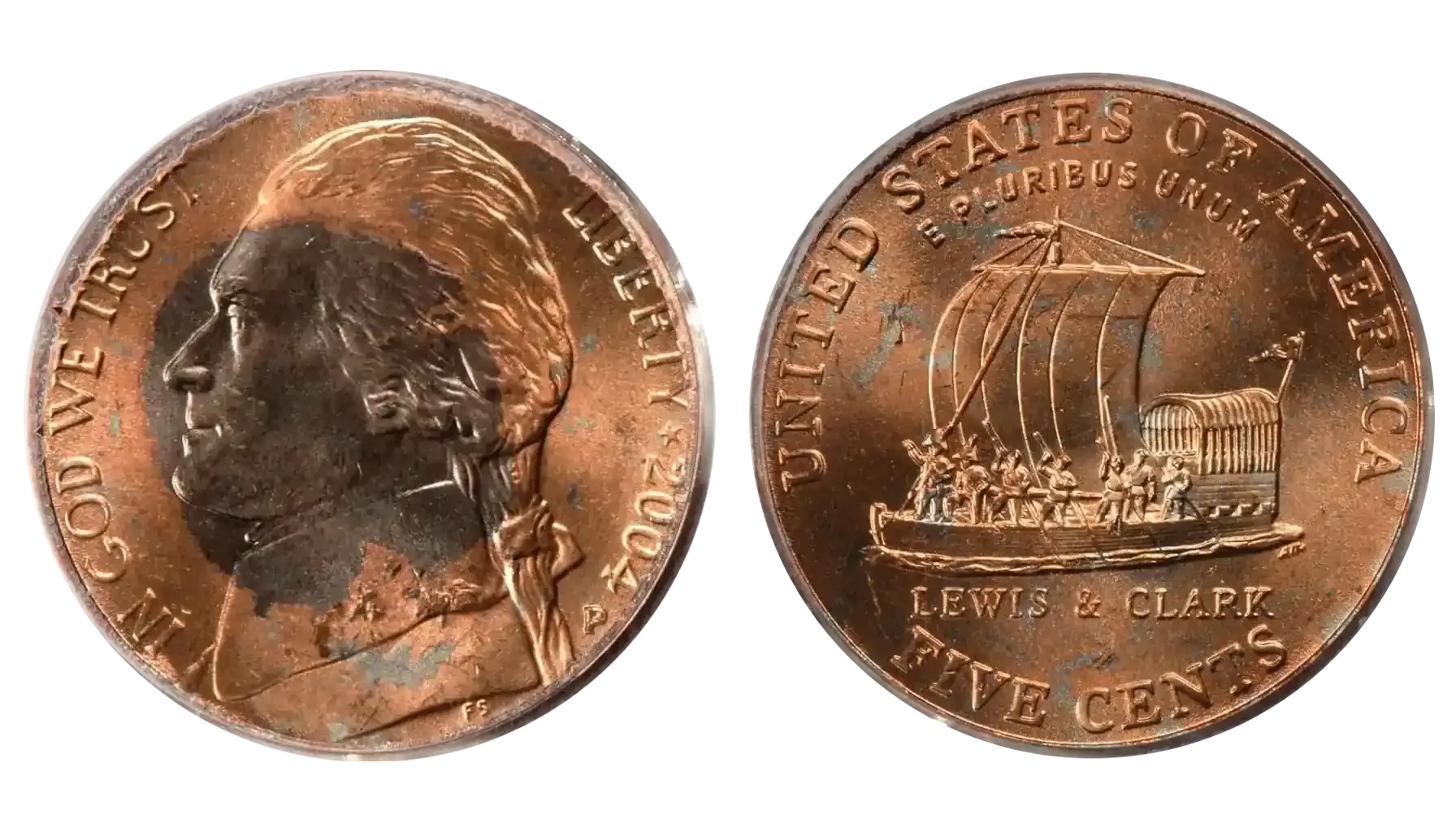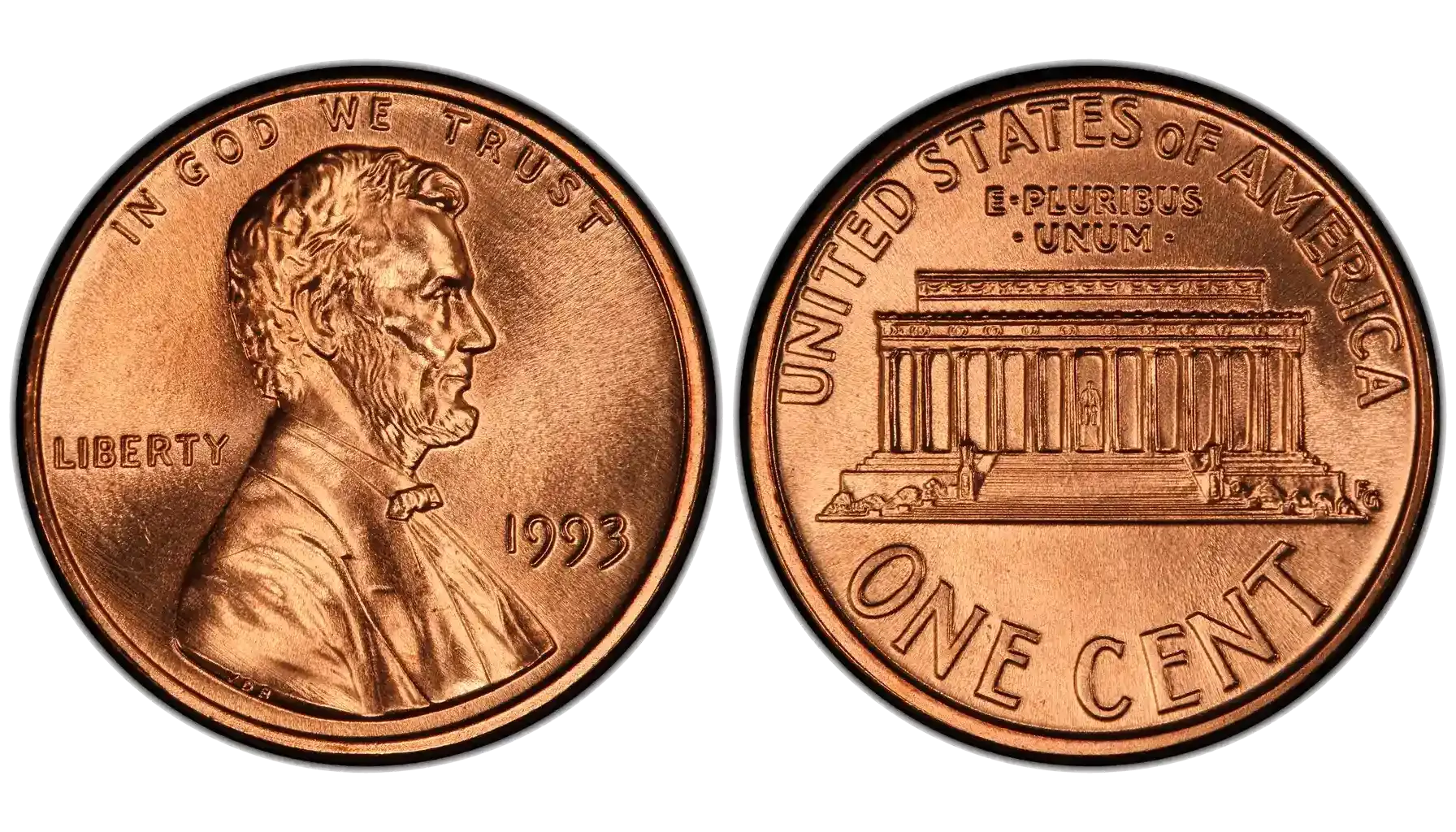Contents:
Commemoration through coins is the finest way to perpetuate what has been accomplished centuries ago. The modern monetary system in the US in its full bloom is just as well as that of the bygone years when physical coins were more heavily circulated and had yet to be overshadowed by digital alternatives.
Turning our heads to the previous decades, here comes a splendid example of modern coinage, i.e., the 2004 Louisiana Purchase nickel. But what features identify this coin? What is the history behind its emergence? How much is a 2004 nickel worth? And why may some instances be worth thousands of dollars on the market?
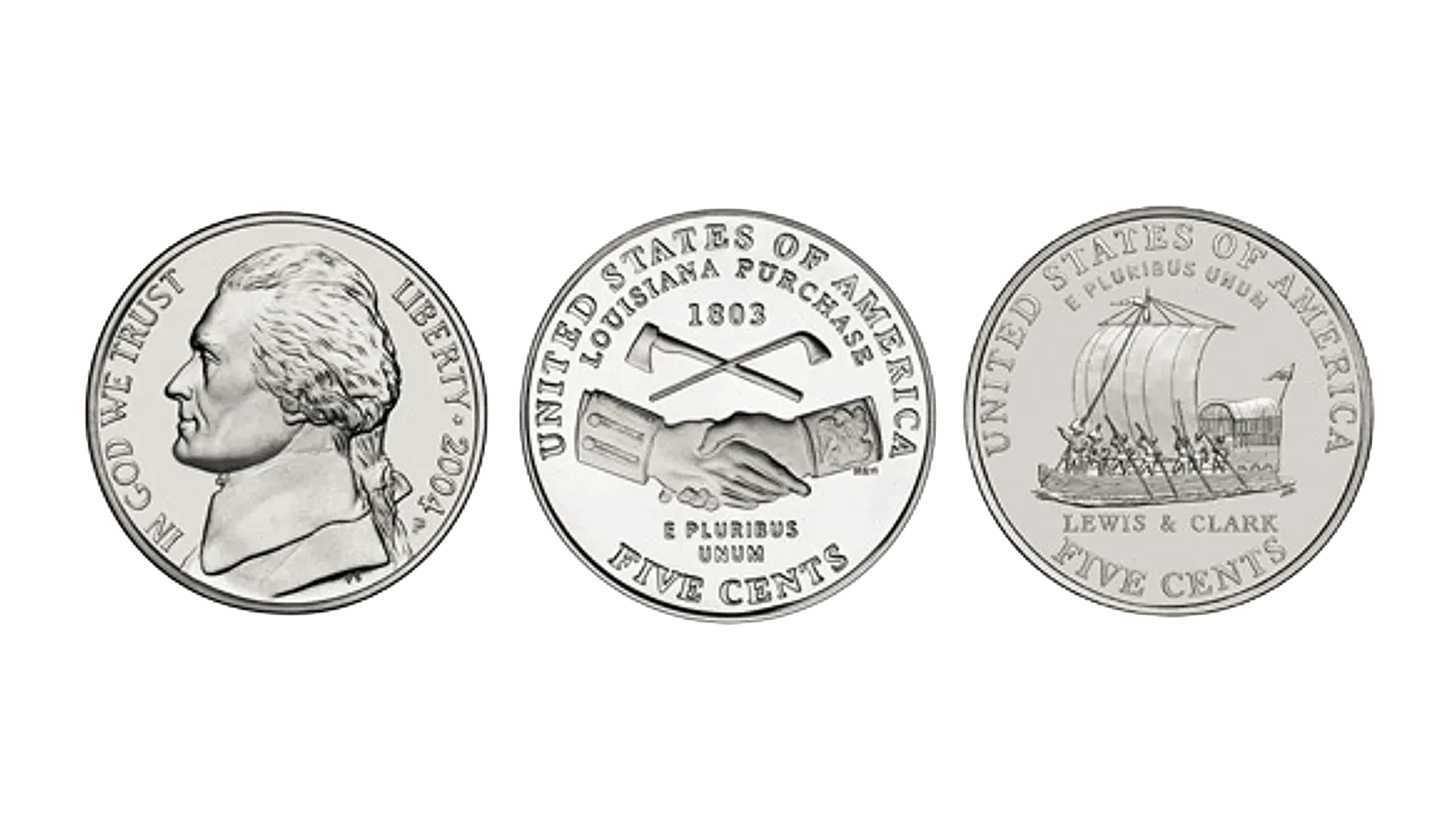
The History Behind the 2004 Lewis and Clark Nickel
The history of American nickels is long and vivid, but even such an iconic coin has had its ups and downs to endure. Back then, in 1866, there was released the first national coin of copper-nickel alloy that bore the face value of five cents. Although the age of nickels saw numerous design solutions, with one of the most notable referring to the Jefferson Nickels design, we are to focus on an outstanding iteration introduced in 2004.
Since 1999, the US Mint has made a few successful attempts to launch commemorative programs, honoring the brightest moments in the history of an aspiring nation. The first one was the 50 States Quarters, and with its success came a new series (2004-2005) aimed at the celebration of the bicentennial of the Lewis and Clark Expedition through nickels – the Westward Journey Nickel program.
Though it was a completely different series, the remnants of its predecessor, the Jefferson nickel, were left in the design anyway. Notwithstanding the previously mentioned facts, this new iteration was only categorized as Type 3 within the same Jefferson nickel key dates series.
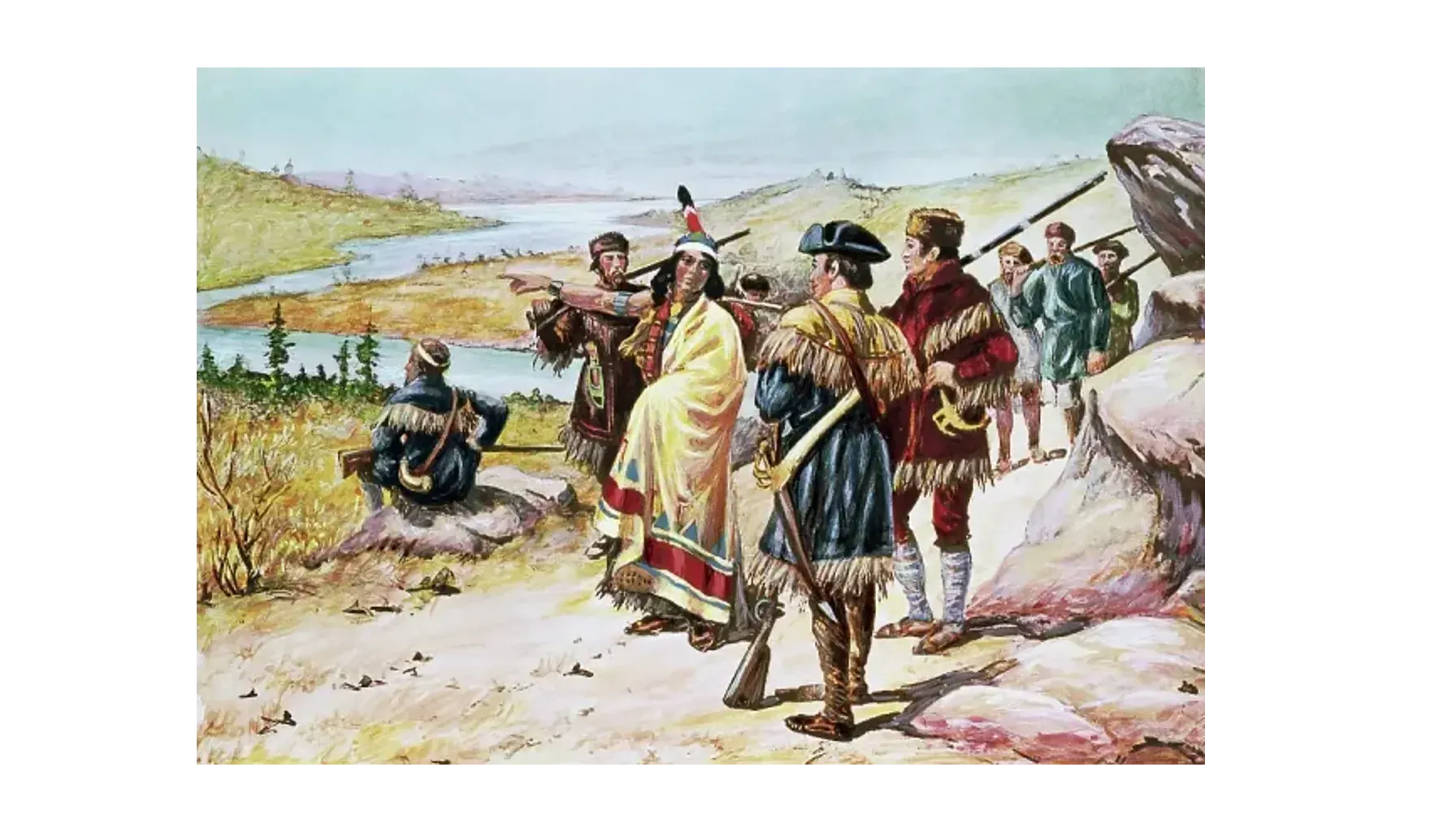
The reason was rather obvious. It was Thomas Jefferson who initiated the Louisiana Purchase and, between 1804 and 1806, commissioned the Lewis and Clark Expedition to chart the newly acquired territory, build ties with Native tribes, and seek a navigable route to the Pacific. This is how the 2004 Nickel Louisiana Purchase appeared.
Related articles: Most Valuable 2000 Sacagawea Coins
Design and the Main Features
The Westward Journey Nickel program was not a simple one-coin-per-season series. In 2004, the US Mint introduced two distinct nickel designs as part of the Westward Journey Nickel Series, i.e., the Peace Medal and the Keel Boat. Both coins commemorate the same groundbreaking event and, hence, bear similar physical specifications, common to all pieces released within the series in 2004 and 2005. However, differences are also noticeable.
Let us take a look at the main features of these numismatic creations to grasp their concepts and realization.
Feature | 2004 Peace Medal | 2004 Keelboat |
Obverse | Portrait of Thomas Jefferson (by Felix Schlag) | Same as Peace Medal (Thomas Jefferson by Schlag) |
Reverse | Hands shaking below a peace pipe and tomahawk by Norman E. Nemeth | A keel boat carrying members of the expedition upriver by Al Maletsky |
Weight | 5.00 grams | |
Diameter | 21.21 mm | |
Thickness | 1.95 mm | |
Composition | 75% copper, 25% nickel | |
Edge | Plain | |
Mint Marks | “P” for Philadelphia “D” for Denver “S” for San Francisco (proofs only) | |
Release Date | Early 2004 | Late 2004 |
Common Varieties of the Lewis and Clark Nickel 2004
2004 P 5C Peace Medal
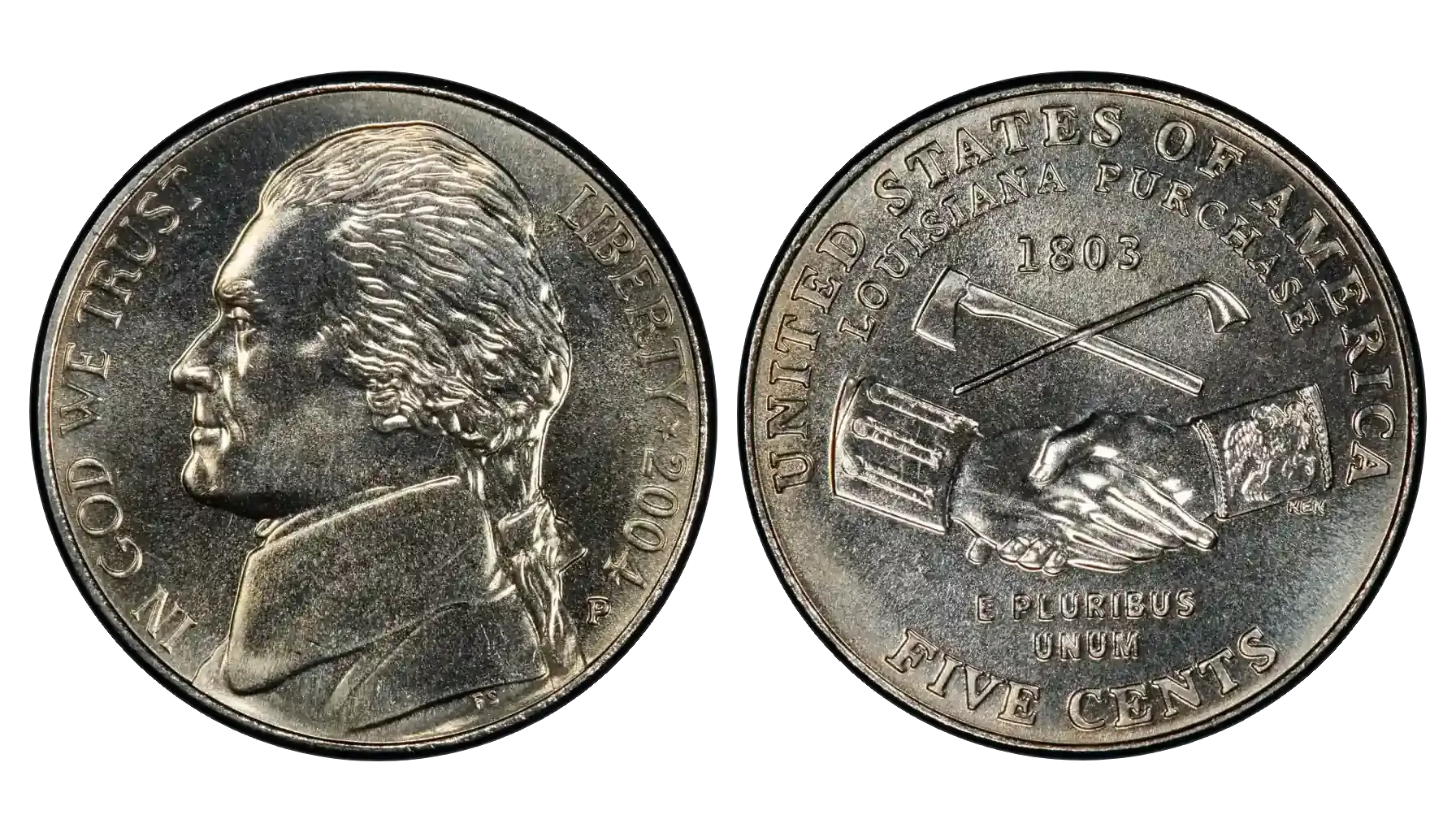
Produced by: Philadelphia Mint
Mintage: 361,440,000
Auction Record: $4,230 for MS68
The 2004 P nickel is a regular-strike instance that features the classic handshake design symbolizing diplomacy with Native American tribes. High-grade specimens (MS68+) are scarce and may be worth more than $4,000 at the most reputable auction platforms like the GreatCollection.
2004 D 5C Peace Medal
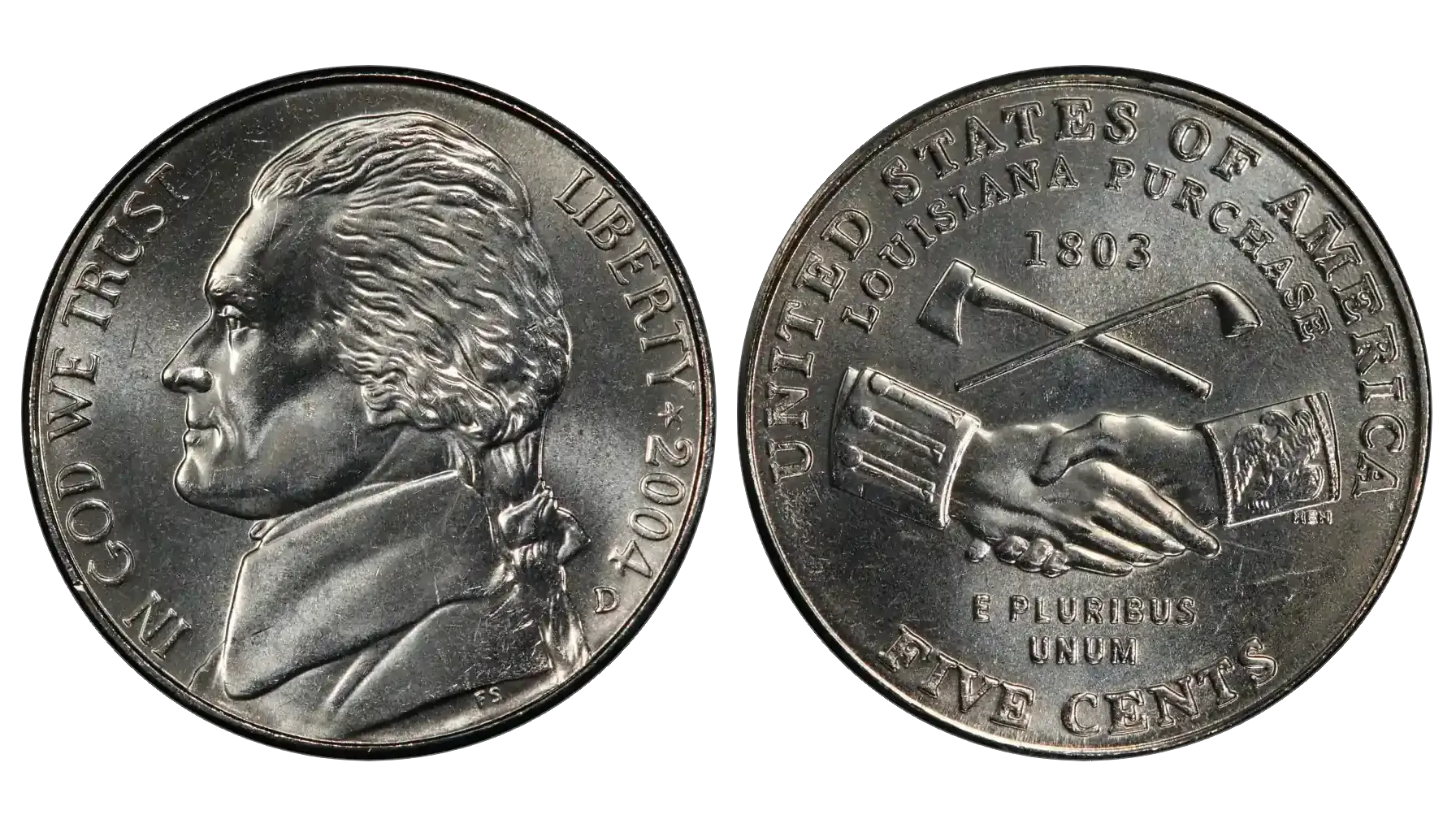
Produced by: Denver Mint
Mintage: 372,000,000
Auction Record: $900 for MS68
This variety is common in circulated grades up to MS66. Finding examples in MS67, however, is indeed difficult, with most high-grade coins likely sourced from original mint rolls in the first place.
2004-S 5C Peace Medal, DCAM (Proof)
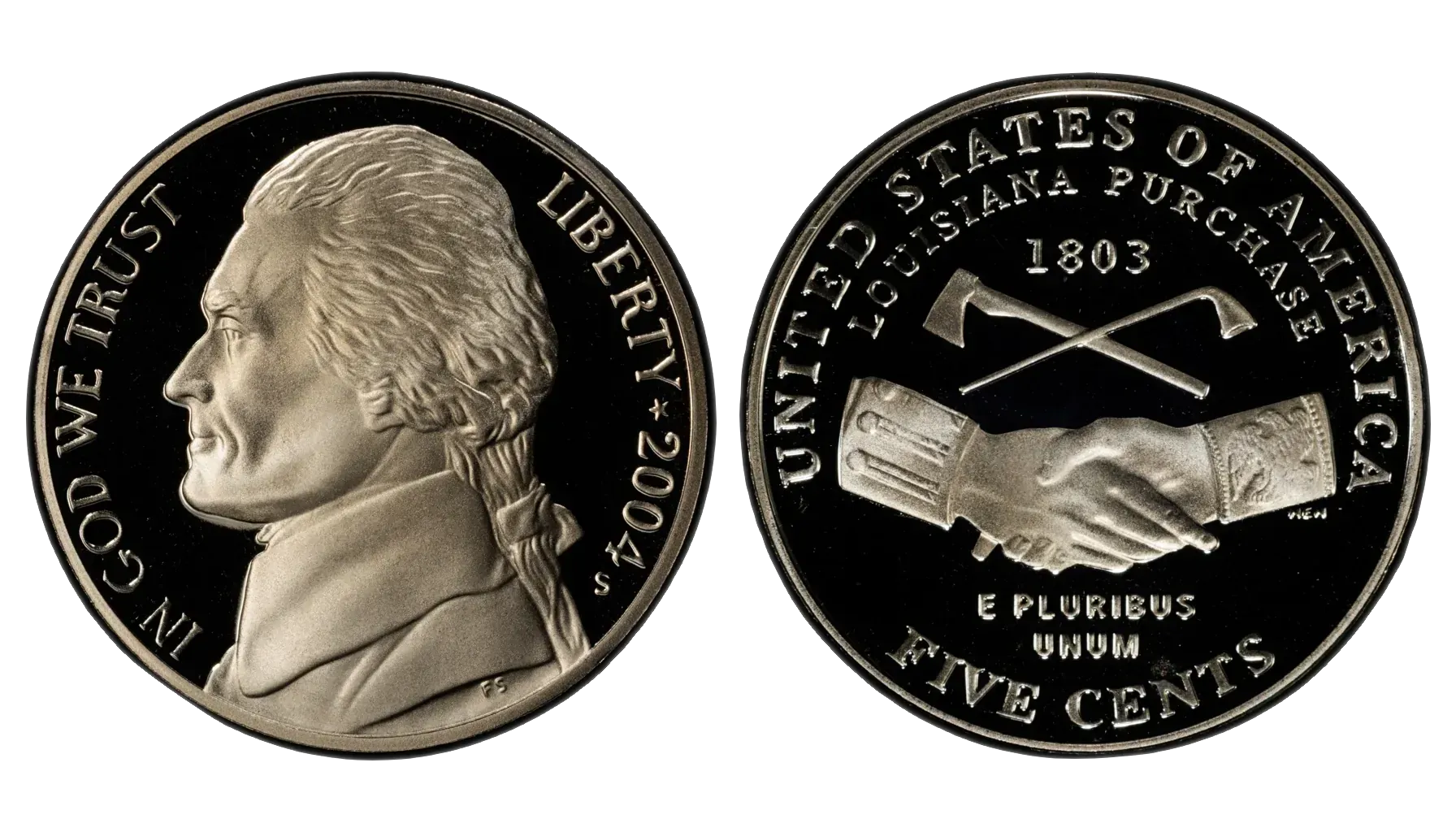
Produced by: San Francisco Mint
Mintage: 2,992,069
Auction Record: $1,725 for PR70
For collectors, there were also released special pieces with a deep cameo (DCAM) designation, which presupposes sharp contrast and mirror-like surfaces. In proof sets, these are common, and the prices will only grow over time.
2004 P 5C Keel Boat
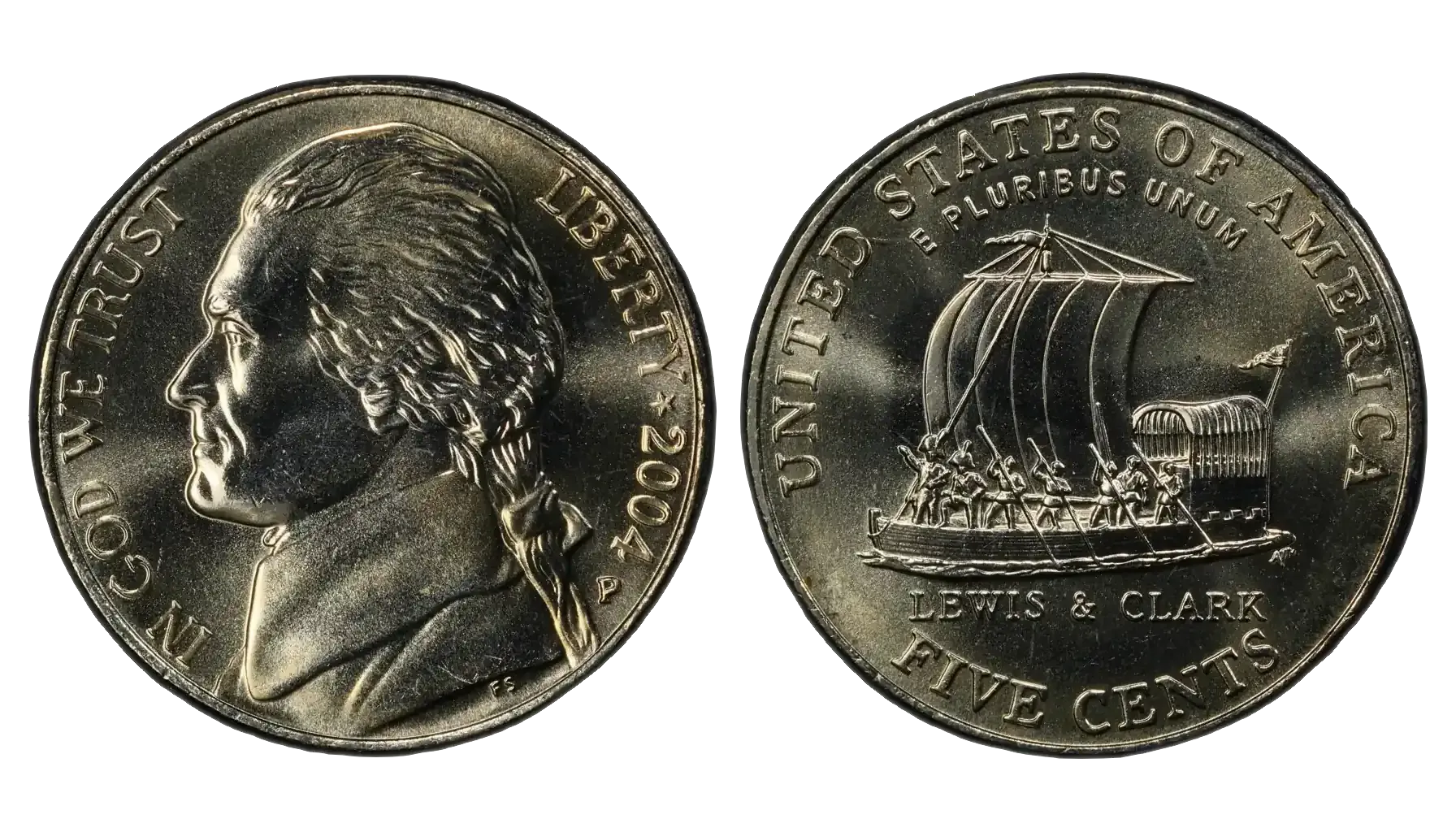
Produced by: Philadelphia Mint
Mintage: 366,720,000
Auction Record: $895 for MS68
Here is another 2004 Jefferson nickel design that features the image of the expedition’s keel boat. As for the grades and collectibility potential, the Philadelphia Mint may boast numerous instances in uncirculated grades from MS60 to MS65.
2004 D 5C Keel Boat

Produced by: Denver Mint
Mintage: 344,880,000
Auction Record: $940 for MS68
This 2004 D nickel variety is slightly tougher to obtain in top grades, though it remains relatively accessible through rolls and mint sets (just like 2001 pennies or a 2005 Buffalo nickel).
2004-S 5C Keel Boat, DCAM (Proof)
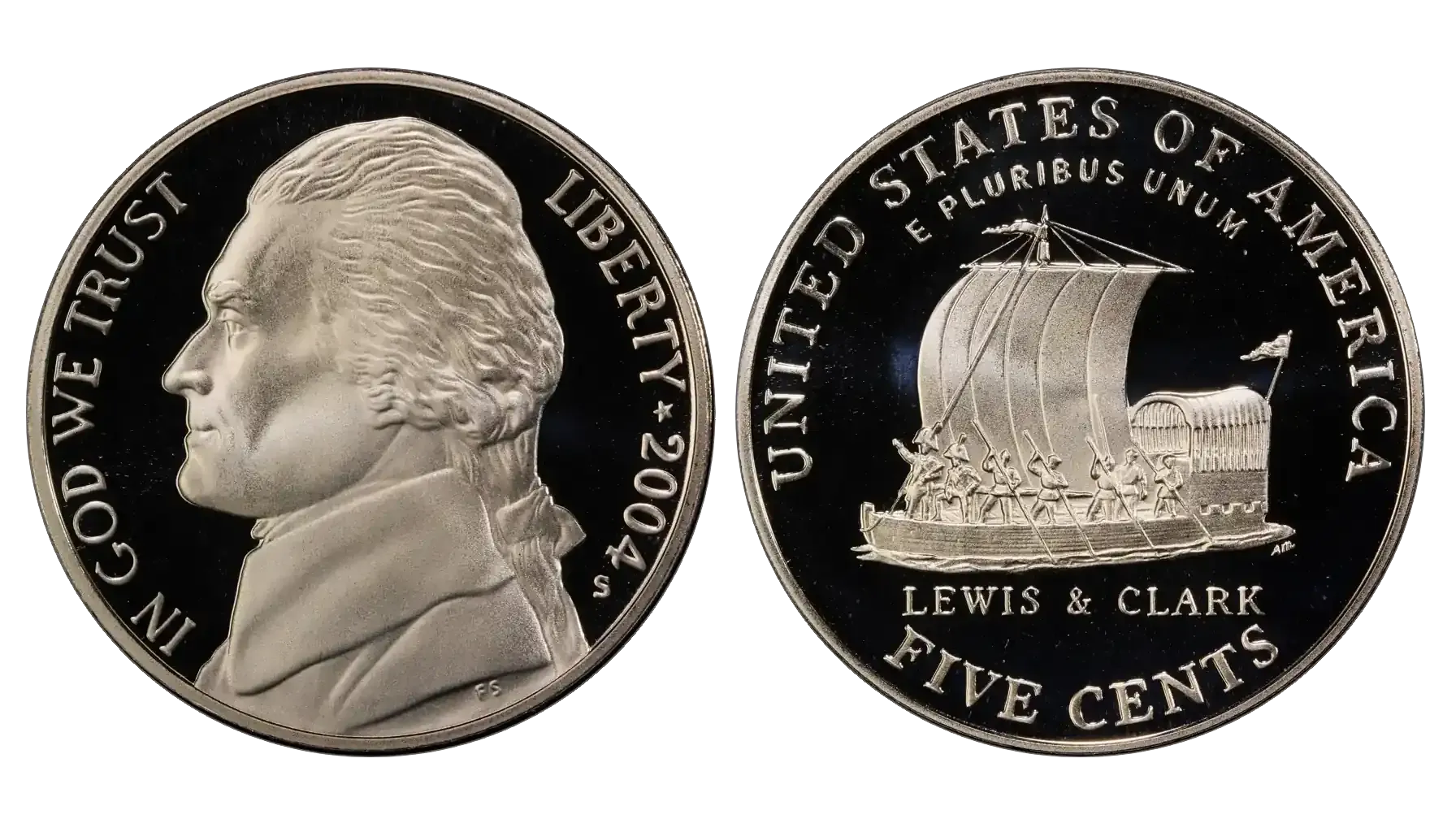
Produced by: San Francisco Mint
Mintage: 2,965,422
Auction Record: $270 for PR70
The proof 2004 nickel Lewis and Clark Keel Boat was also struck in a deep cameo finish for collectors. And yes, they are widely available, too, with the highest-graded PR70 examples still bringing surprising results (though typically lower than that of the Peace Medal proof variant).
2004 Nickel Errors Explained
Error coins are as diverse as coins themselves. This is why determining the strict list of deviations is unreasonable, for new flaws may be discovered at any time after the release. Here are a few peculiar 2004 Lewis and Clark nickel errors that one may find in circulation (or on the Net).
Broadstruck and 15% Straight Clip (Keel Boat 5C)
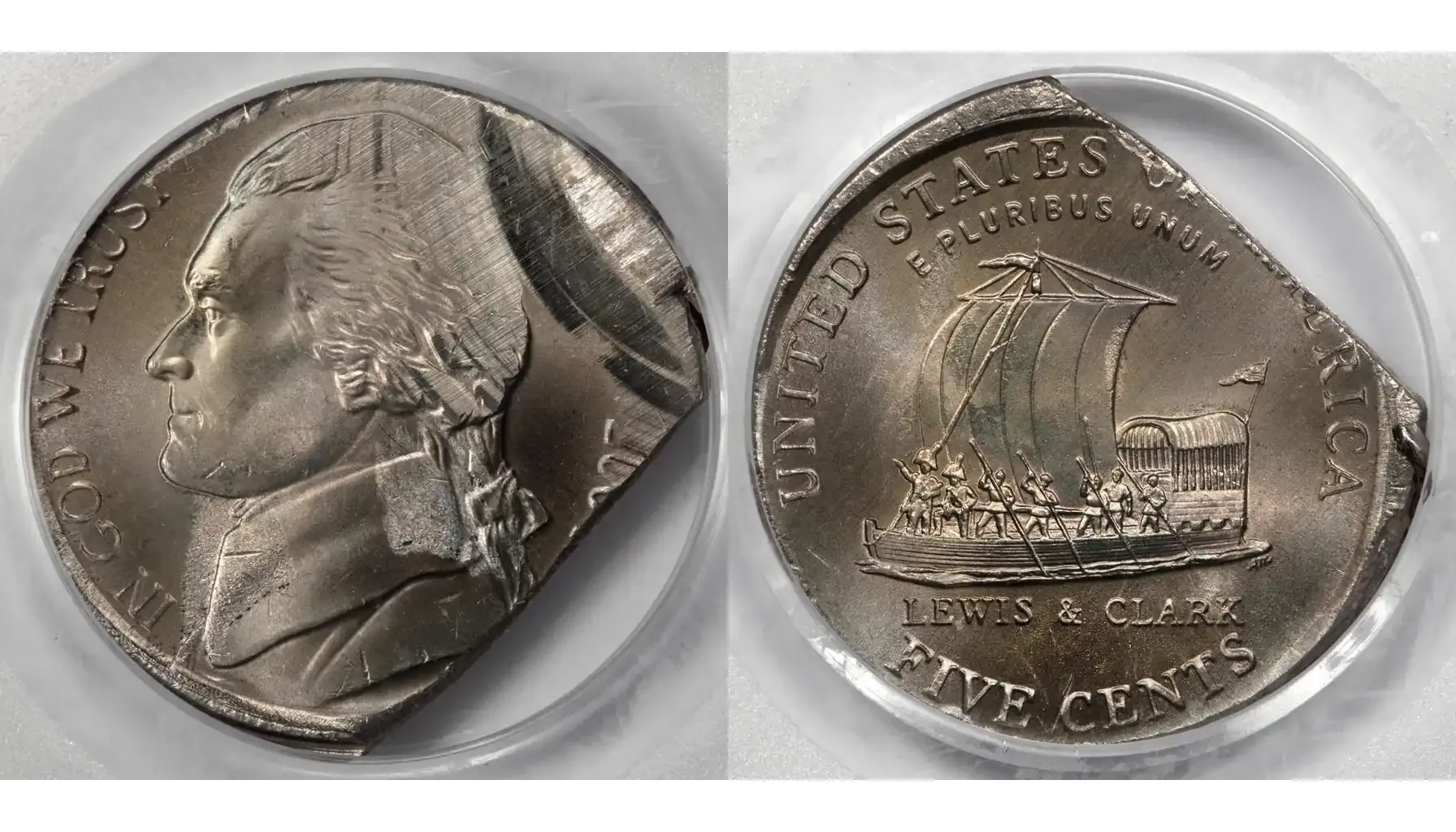
Estimated Value: $1,250
This mint error combines two striking issues, i.e., the coin was broadstruck outside the collar, causing a flattened, distorted rim, and also features a 15% straight clip with part of the planchet missing.
Reverse Die Gouge (Keel Boat 5C)
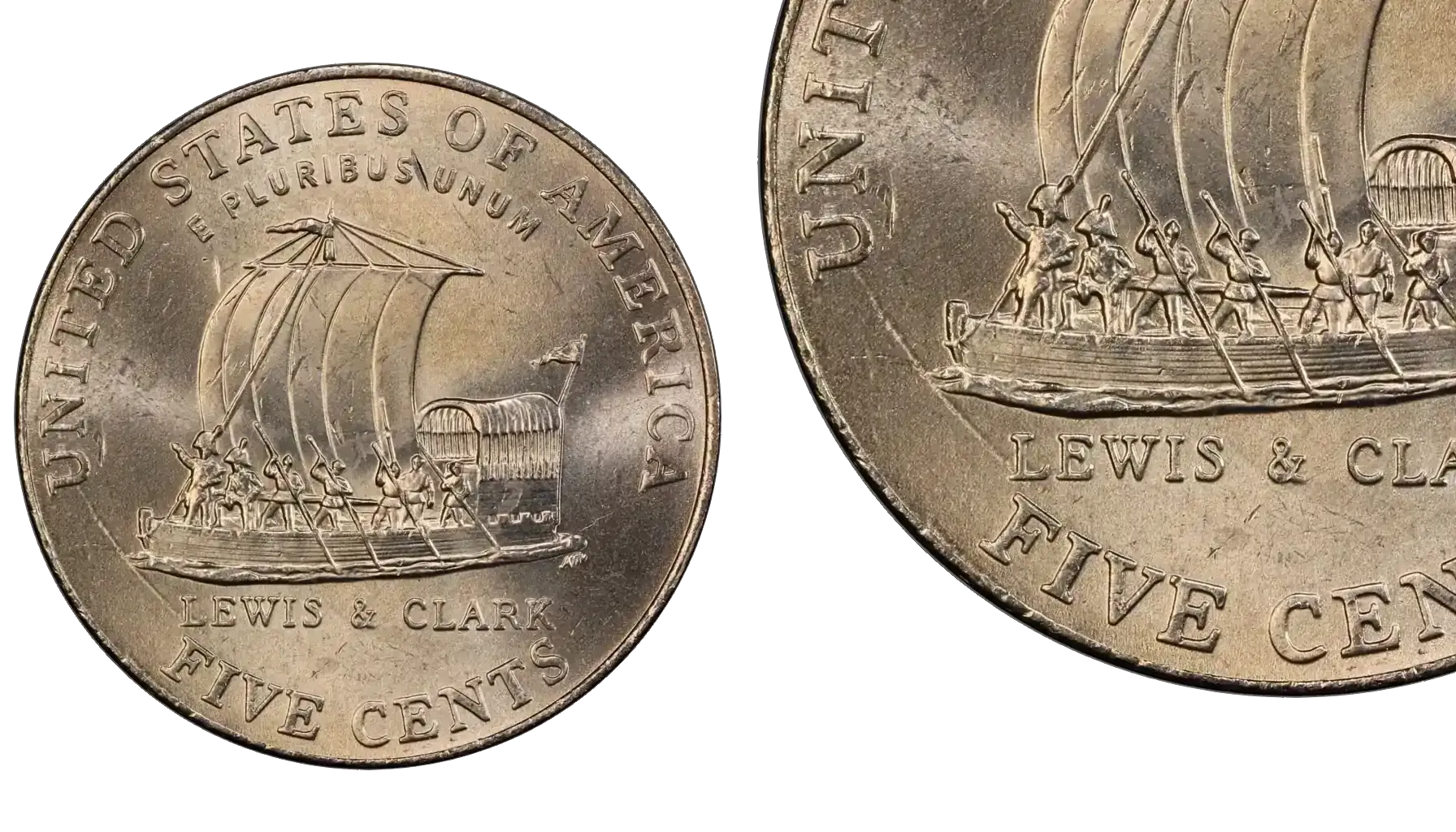
Estimated Value: $585
A prominent die gouge on the reverse created an abnormal mark, usually caused by damage to the die. This type of 2004 P Lewis and Clark nickel error is rare and can be of particular interest thanks to its unusual appearance.
Improperly Annealed Planchet (Keel Boat 5C)
Estimated Value: $300
In the case of this 2004 Louisiana Purchase nickel error, the coin is created with unusual coloring (more of a reddish-blackened shade) due to incorrect heat treatment during the annealing process.
DDO – Doubled Die Obverse (Peace Medal 5C)
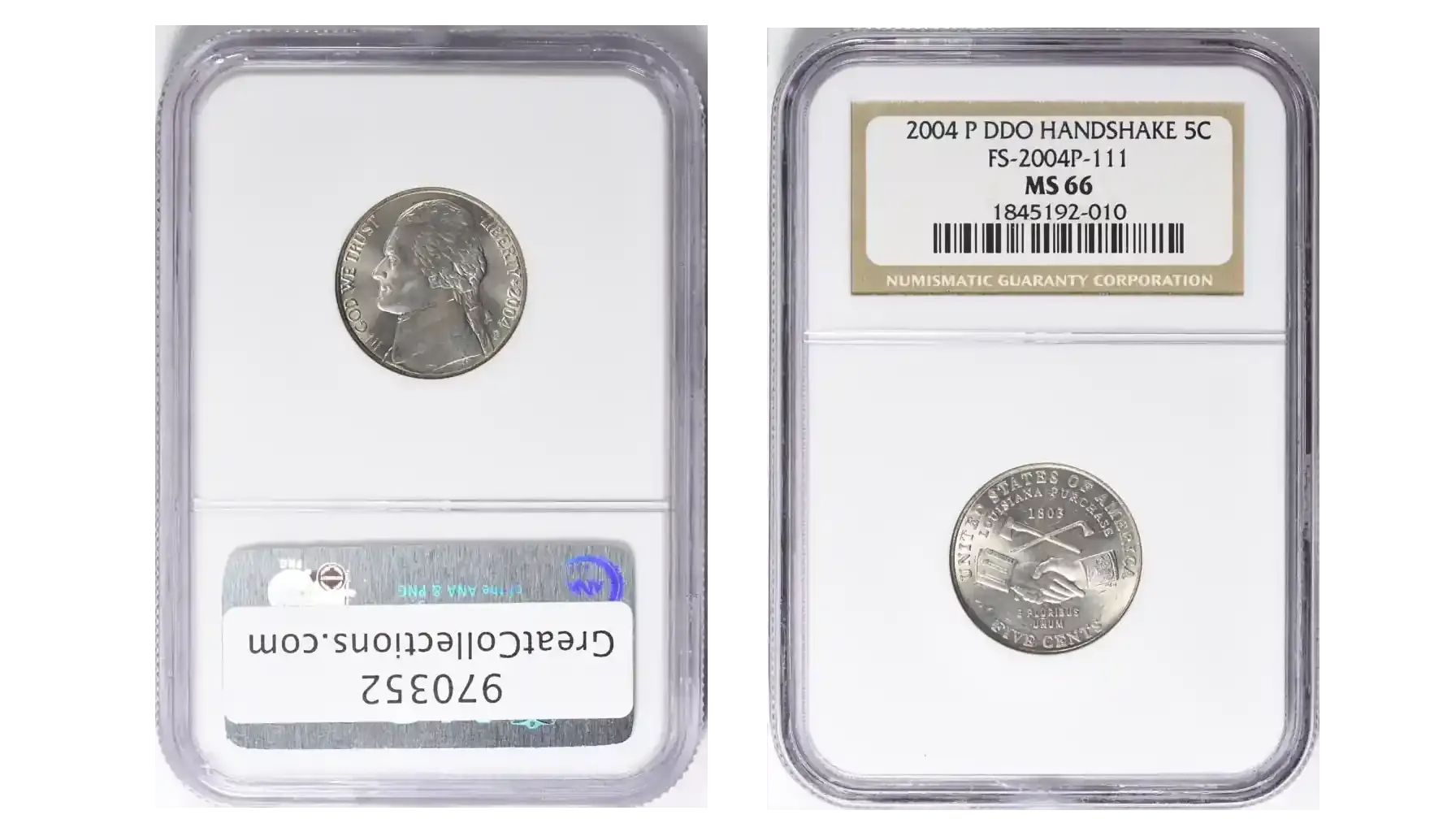
Estimated Value: $200
One of the most widespread deviations is the DDO, i.e., Doubled Die Obverse. As a rule, doubled die obverse results in doubling on elements like the date, inscriptions, and profile features. For newcomers, it might be a wise choice because of accessibility and worth.
The 2004 Nickel Value: Facts and Figures
The 2004 Louisiana Purchase nickel value varies, and this mainly comes from the coin's condition, mint mark, type, errors, and proof characteristics. The Lewis and Clark nickel 2004 worth usually equals the face value (when it comes to the circulated instances). As for higher-grade specimens, please consult relatable databases provided by Coin ID Scanner or other resources, and take a look at the following table that reveals the 2004 Lewis and Clark nickel value as of 2025.
G–XF | MS60–MS64 | MS65–MS67+ | Proof | |
2004-P PM | $0.05 – $0.25 | $0.50 – $2 | $5 – $150 | N/A |
2004-D PM | $0.05 – $0.25 | $0.50 – $3 | $10 – $100 | N/A |
2004-P KB | $0.05 – $0.25 | $0.50 – $2 | $5 – $100 | N/A |
2004-D KB | $0.05 – $0.25 | $0.75 – $3 | $10 – $125 | N/A |
2004-S PM | N/A | $2 – $50+ | ||
2004-S KB | N/A | $2 – $35+ | ||
Explore modern numismatics and find solutions that suit your taste. The 2004 issues are definitely a great place to start.

